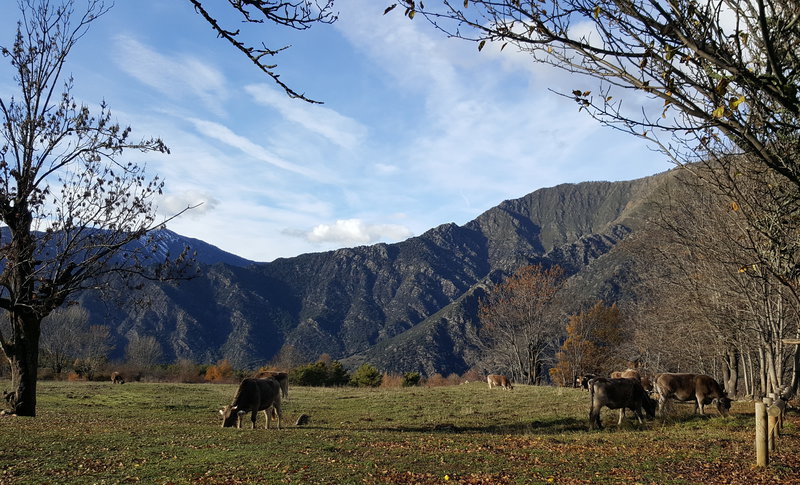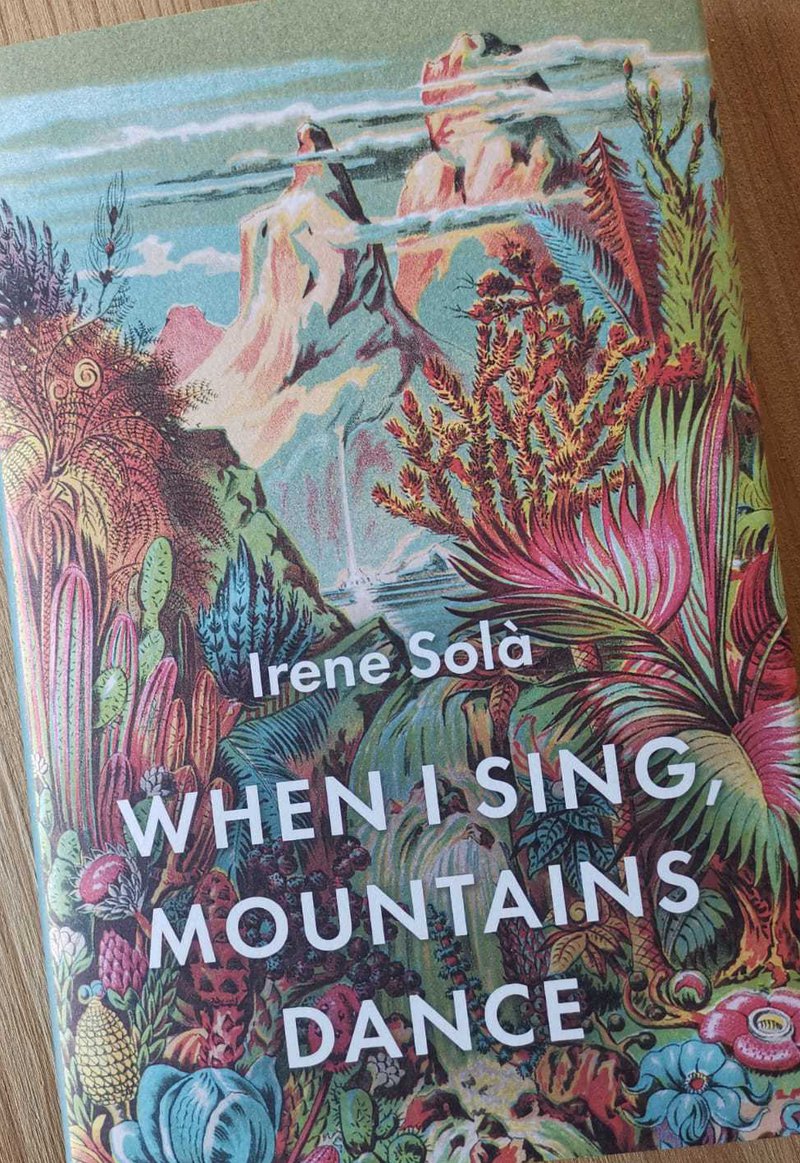Mountain jigsaw
This is the story of a village in the high Pyrenees, near the French frontier. At its centre is Mia, assailed by the sudden death of her loved ones. Yet, surrounded by the fury and beauty of nature, she finds startling stillness and joy in her daily life.
When I Sing, Mountains Dance is an up-and-down roller-coaster novel like the steep valleys and high peaks. It leads its reader through the winding paths of the thick forest, then ties all its plot-lines skilfully and movingly at the end. Its characters are modern people with computers and motor cars and it is also a story inhabited by dead Republicans, water-sprites, four women hanged for witchcraft, bears, dogs and deer.
Mobiles and witches
Chapters are narrated by these animals and by the unquiet ghosts of the past. Chapters are even told by the apparently inanimate thunder storm and mountains. The Pyrenean rock may appear unchanging, but the long and witty central chapter Crunch, with drawings too, is narrated by the mountains that forced themselves upwards millions of years ago. The past is alive and present in these mountains’ people’s minds. Mia and other characters are well aware that they are not the centre of the world, but just a small part of a fierce and beautiful world and history.
“We arrived with full bellies” is the book’s opening line. The thunderstorm is narrating. It laughs as its icy rain slides down the back of Mia’s father, the oral poet and farmer Domènech, then strikes the poor man dead with lightning. The four women, murdered 300 years ago, then approach his body and tell their story of the horrors of witch trials while scooping up the black chanterelles Domènech had collected.
Each chapter has a different narrator - some narrators get a couple. Most chapters, several based on Catalan legends, are a short story in themselves. Solà reminds me of Bernardo Atxaga in how her rural characters live with normality their closeness to modern city life - cars, mobiles, coffee-shops, books etc. - and at the same time dwell naturally in a world where animals think and the dead talk. Mia, for instance, is not surprised when her friend Neus tells her she has an evil presence in her house that needs to be expelled or when her dead brother chats to her in the kitchen garden. Atxaga’s prose style, though, is calm and crystal-clear, whereas Solà’s writing is full of action and agitation, packed with adjectives and colours. Everything is mobile, like wind, rain, mountain streams and human history. Her characters are a part of this nature, not apart from it. It really is an exciting novel.
Dog’s-eye view
My favourite chapters of several were the two narrated by Lluna, Mia’s dog. Solà brilliantly takes readers inside Lluna’s mind, showing why she barks or growls or why she runs flat out to Mia when Mia whistles. And, as in all the chapters, Solà immerses herself in the narrator’s point of view, yet does not neglect to move the plot along, often with just a word or phrase. It is a jigsaw of a novel: you often don’t know where each character is going and in the end it all fits together.
Here’s a sample from Lluna:
“What I like best is when she whistles. With her fingers in her mouth. Because then I come running. I run as hard as I can, I jump, I fly like one of those little birds you just want to catch in your mouth, because they’re pretty and fast, and then grind your teeth together and feel all their bones break. When she whistles I run over the grass and the fences and rocks…” (p.137)
You can hear her racing and panting. Solà has many comic touches, too: Lluna has no inhibitions and describes Mia having sex. Another quiet, sly joke is that the very practical, down-to-earth bailiff’s wife is the witch-exorcist Neus, whose name means Snows and can tell when it’s going to snow more accurately than Tomàs Molina.
It is a story of women alone: Sió without her husband and giving birth in the forest; Mia with her family dead and without her lover; or Palomina, the girl who lost her family and her life in the retreat before Franco’s armies. The mountains inspire fear. Children still find discarded grenades or guns, for the village lies on one of the routes of the Republic’s soldiers crossing into France in 1939. The women are afraid, lonely and tough as the old boots Lluna likes to chew.
Mara Faye Lethem, who has translated a number of novels from Catalan, excels. Her task was not easy: there are multiple voices, slang and rhythm to capture. She boldly follows Solà’s freedom with words. In the middle of the book (chapter called The Setting), a hiker from the city visits the village and finds everything shut because of a death in a hunting accident. The irritated walker understands nothing, for she/he is outside local feeling and history; whilst at the same time she extols in cliché the mountains beloved by “dear old Verdaguer”. They are “sublime. Primordial. Otherworldly. Legendary. Epic.” Lethem catches Solà’s satire, the tone of the outsider: “Emotions are more naked up here, too. More raw. More authentic.” Like much of the book, the chapter is both brutal and funny.
The only slightly annoying aspect of this fine novel was Solà’s tendency to string phrases together with ’and’ and ’and’, as if carried away by her own rhythm. This defect, if it is one, is a virtue, too. For instance, in the chapter narrated by a roe-buck that runs and runs and runs through the forest, the repetition echoes his precipitate flight from hunters. Solà’s language is exuberant; her narrative control, impressive; her images, stunning: her stories, moving. This short novel is a great pleasure to read.
book review
The story of a woman who…
With Canto jo i la muntanya balla, Irene Solà won the 2019 Anagrama prize for novels in Catalan and was one of the winners of the 2020 European Union prize for Literature. Els dics (The Dams, 2018) received the Documenta first-novel prize. She is a poet, too - there are several poems in When I sing…-- and won the Amadeu Oller prize for her first book Bèstia (Beast, 2017, in English). She is also a visual artist, with her works shown in Barcelona’s CCCB and London’s Whitechapel Gallery.
Born in 1990 in the village of Malla, some 8 kilometres from Vic, Solà has a Fine Arts degree from the University of Barcelona and a Master’s in Literature and Film from the University of Sussex. She is not just individually successful, but is involved in several collective projects, such as the fanzine Vols russos, published some years ago by a group of young artists in Girona.
Her 2020 exhibition Hi ha una història d’una dona que (There’s a story of a woman who) picks up on the four witches who speak in When I sing… Solà explained: “I am interested in giving witches a voice, for we don’t know what they thought. Everything we know has reached us through what those men said at their trials.” Feminist, poet, historian, plastic artist and novelist. I’ll be buying her first novel and looking out for the third.




